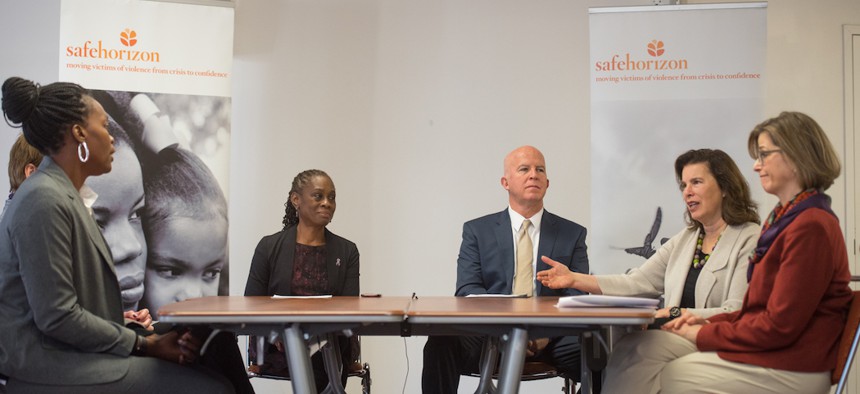New York City
What role should police play in New York’s mental health response?
The COVID-19 pandemic is creating a mental health crisis, and recent turmoil amid protests against police brutality may make it more acute.

First Lady Chirlane McGray meets with then-New York City Police Department Commissioner James O'Neill and then-Deputy Commissioner of Collaborative Policing in the NYPD Susan Herman at Safe Horizon, discussing how to help victims of crime and violence hea Edwin J. Torres/Mayoral Photo Office.
A mental health crisis has been looming ever since the COVID-19 pandemic began – and now, turmoil and violence erupting during recents protests against police brutality threaten to further the fear and trauma New Yorkers are experiencing.
“Witnessing the kind of violence that the whole country has watched over the last week or so is traumatic for everybody,” Susan Herman, senior adviser to the New York City Mayor Bill de Blasio and director of ThriveNYC, said during City & State’s webinar on Tuesday. “Because it’s been broadcast, more and more people have been able to see what black and brown people live with everyday.”
Police officers often also serve as first responders when mental health crises occur, but critics say they tend to be poorly equipped to help people and may needlessly respond aggressively. One notable case is when NYPD officers shot and killed Saheed Vassell, a black man with a mental health disorder, in 2018 after mistakenly believing he was carrying a gun. As scrutiny of policing practices reaches a fever pitch, calls have increased for city officials to defund police departments and to shift responsibilities to respond to vulnerable communities – including the mentally ill – to health care and social workers instead.
“The NYPD’s budget is seriously inflated,” said New York City Councilwoman Diana Ayala, who chairs the committee dedicated to mental health. “I wouldn’t say that I’m in favor of defunding the NYPD, but I believe that there is a serious discussion that needs to be had about just how significant or insignificant the cuts that have been proposed to date have been.”
The NYPD would see about 0.4% of its budget, or $23.8 million, cut under the mayor’s proposal, which has been criticized by council members, especially as youth and education services face major cuts.
Mental health officials in New York City have made some efforts to rely less on police involvement. Mobile crisis teams of social workers and people with lived experiences through certain crises can be deployed through hospitals or by individuals through the city’s NYC Well website to respond to people in need. The city has also expanded its use of similar Health Engagement Assessment Teams, also known as HEAT Teams, which include mental health professionals and peers who can respond to non-emergency calls for help from city agencies and 311.
“We have lots of health-only responses and we continue to experiment with broader use of each of them,” Herman said. But these initiatives have limited reach as they are mostly focused on non-emergency responses and are hampered by response times that have averaged about 17 hours – leaving lots of mental health responses in the hands of police.
City and state officials have also touted efforts to train members of the NYPD and other police departments across the state to engage with people with mental health disorders more carefully. About three-fourths of patrol officers in the NYPD have received crisis intervention training to better identify people with mental illness so they can adjust their approach, Herman said.
“Training is something that is ongoing,” said Ann Marie Sullivan, commissioner of the state Office of Mental Health. “Sometimes people think you can do one-shot training and that works. And that’s not what’s happening in the city and that’s not what’s happening in the state. And you need to have debriefings when incidents occur, you need to talk about how to handle them.”
A coalition of advocates and nonprofits focused on mental illness have previously criticized the city for not going far enough in its initiatives to disentangle its mental health response from the criminal justice system. Some mental health experts have also been supportive of a proposal from New York City Public Advocate Jumaane Williams to create a new phone number separate from the NYPD that people can call into to receive immediate mental health support.
The need to address mental health has become all the more acute as depression, anxiety and post-traumatic stress disorder are expected to rise as a result of widespread coronavirus-related deaths, large-scale unemployment and isolation. Demand for help through the Crisis Text Line has increased by 50% since the onset of the pandemic, Sullivan said.
“Thank god they are actually asking for help or trying to talk to someone,” Sullivan said, “which is probably one of the best preventive measures.”
Correction: An earlier version of this post incorrectly referred to the Crisis Text Line as a state government program.
NEXT STORY: NYPD officers eschew masks during protests

